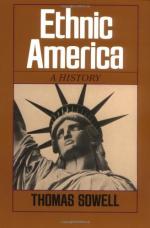
|
| Name: _________________________ | Period: ___________________ |
This test consists of 15 multiple choice questions and 5 short answer questions.
Multiple Choice Questions
1. How many people died of starvation or illness during the Great Famine of the 1840s in Ireland?
(a) Five million.
(b) Two hundred thousand.
(c) One million.
(d) Five hundred thousand.
2. How did Jews who had survived persecution store their wealth?
(a) Gold and jewelry.
(b) Works of art.
(c) Expensive clothes.
(d) Home furnishings.
3. With acculturation, IQ rates tend to:
(a) Fall.
(b) Remain constant.
(c) Become insignificant.
(d) Rise.
4. How did the system of tenant farming undermine Irish initiative?
(a) No improvements were permitted.
(b) All improvements would be reversed.
(c) All improvements were heavily taxed.
(d) All improvements belonged to the landowner.
5. Where do most people of Irish ancestry live?
(a) In Ireland.
(b) In the United States.
(c) In the British Isles.
(d) In Canada.
6. What percentage of immigrants from southern Italy returned home?
(a) 10%.
(b) 70%
(c) 40%.
(d) 90%.
7. Why did farmers in southern Italy live on hillsides?
(a) To avoid malaria.
(b) To hide from invaders.
(c) Because arable land was in the hills.
(d) To get a better view.
8. How did Europeans treat Jews as they became the only non-Christians on the continent?
(a) They were quietly disliked.
(b) They were welcomed and venerated.
(c) They were persecuted, massacred and expelled.
(d) They were supported and helped.
9. How did Italian immigrants to the U.S. regard education?
(a) With hostility.
(b) With hope.
(c) With confusion.
(d) With gratitude.
10. What was a "Hessian"?
(a) German soldiers recruited to fight in the Revolutionary War.
(b) German communitarians.
(c) German pacifists.
(d) German government officials.
11. At the turn of the century, what was the population density of the lower East Side in New York?
(a) One hundred people per acre.
(b) Five hundred people per acre.
(c) Two hundred people per acre.
(d) Seven hundred people per acre.
12. What Irish product undermined the welfare of Irish people?
(a) Potatoes.
(b) Whiskey.
(c) Poetry.
(d) Sabotage.
13. Which ethnic group got along best with the Indians?
(a) Scotch-Irish.
(b) British.
(c) Celtic Irish.
(d) Germans.
14. Which ethnic group has the highest fertility rates?
(a) Polish Americans.
(b) Mexican-Americans.
(c) Blacks.
(d) Chinese Americans.
15. What advantages did early Irish immigrants have over others?
(a) They were hard workers and used to urban life.
(b) They had skills for industrialization.
(c) They had business acumen and education.
(d) They spoke English and many were literate.
Short Answer Questions
1. What did the term "ghetto" originally mean?
2. How much of the arable land in Ireland was used for growing potatoes before the famine?
3. How long did it take to cross the Atlantic in a steamship?
4. What percentage of arrests in New York City during the 1850s were made of drunk and disorderly Irishmen?
5. What advantages does northern Italy have over southern Italy, where most emigrants lived?
|
This section contains 454 words (approx. 2 pages at 300 words per page) |

|




